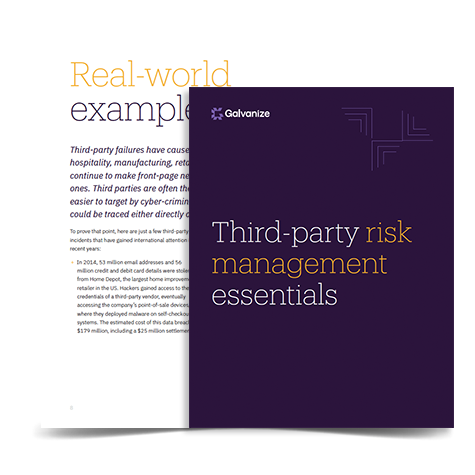Traditionally, third-party risk management (TPRM) has focused on procurement, executing contracts, managing relationships, and conducting quarterly business reviews. But with today’s organizations relying on vendors to fulfill core business objectives and support competitive advantages, these measures are no longer enough.
Stories of security breaches, regulatory fines, and economic losses due to third-party incidents are increasing in number. And although vendors are technically at fault, organizations are ultimately responsible. Since you can’t outsource liability, TPRM programs must manage this elevated level of risk.
Here’s some practical advice on how to integrate expanded TPRM processes into your current sourcing and procurement functions so you can oversee the entire vendor life cycle and scale your program to meet these new challenges.
Understanding your third-party risk
Your organization likely contracts with thousands of third parties, which may include suppliers, manufacturers, service providers, business partners, affiliates, brokers, distributors, resellers, and agents. While you likely have a process in place for onboarding vendors and verifying compliance, there are so many variables at play that it’s easy to overlook potential risks that could become issues over time.
Risks from third parties fall into a number of categories, including:
- Compliance—Are all of your regulatory requirements, such as data storage, being honored by your vendors?
- Cybersecurity—How strict are your vendors’ cybersecurity protocols, and could they leave you vulnerable to a breach?
- Reputational—Are your vendors violating laws or regulations, losing customer data due to negligence, or making controversial statements?
- Financial—Is your vendor likely to go out of business or become insolvent?
Let’s look at cybersecurity as an example of where you may find unknown risk. IT vendors make up just a fraction of your third-party ecosystem. However, in this sector alone, the average organization has 182 vendors connected to their system each week, and 58% of them believe they’ve incurred a breach as a direct result of a third-party vendor. Organizations often lack visibility into their IT risk: 57% don’t know if their safeguards are sufficient to prevent a data breach, and only 34% have a comprehensive inventory of all the third parties that touch their data.
It’s clear that in order to prevent unnecessary risk, your organization needs to develop a systematic approach to managing controls and assessing risk levels in real time.
Optimizing your third-party risk management
Consider these best practices for monitoring and managing your third-party risk:
- Take inventory of all of your third-party risks, including factors such as geography, technology, and credit risk. As you map out and evaluate your third-party risk factors, prioritize each risk based on how likely it is to occur and the impact it would have on your operations. You can also classify vendors by level of risk, such as the type of access they need to your data, and calibrate your risk monitoring accordingly.
- Build mitigation plans. Once you’ve mapped out your risks, develop key risk indicators (KRIs) to serve as benchmarks for when mitigation actions should be put in place. Identify the stakeholders throughout your organization who are responsible for outlining mitigation plans and putting them into practice when needed.
- Standardize and automate your onboarding and termination processes. When onboarding a new vendor, or terminating them at the end of service, establish a strict set of controls that must be followed at every step of the process. This might include reviewing the vendor’s contracts, cybersecurity protocols, incident response plan, business continuity plan, and credit profile. These controls should be automated to the extent possible, so that you can receive prompt notification when problems arise.
- Ensure all risk management team members have access to the same data. Make use of an integrated, centralized risk management platform that provides access to all of your third-party data and allows you to view risk analysis across the entire organization in real time. By building a collaborative platform, you can ensure that every team member has complete visibility and is measuring risk based on the same metrics.
- Use pre-built content to automate your workflows. Your solution should include pre-configured content for common use cases in your industry, which you can use to automate workflows that set up and manage your controls.
- Use analytics to test scenarios and evaluate risk levels in real time. Your solution should include a variety of analytics dashboards to help you evaluate different scenarios and integrate real-time data feeds for up-to-date risk assessment. It should also help produce intuitive reports that you can share with your executive team for better and faster decision-making.
By building and implementing strict protocols around your third-party risk management within a best-in-class integrated risk management solution, it’s easier to classify vendors and identify which ones must be monitored more carefully. You’ll also gain access to real-time data to help you spot problems immediately. And you’ll have access to streamlined workflows that will automate the bulk of your compliance initiatives.
Your third-party vendors are often your weakest link—but by carefully analyzing all of your risk and by enhancing visibility to spotlight problems and trends more quickly, you’ll be able to tighten controls and elevate your organization’s security from end to end.
eBook:
Third-party risk management essentials
This eBook explores the:
- Basics of third-party risk management.
- Difference between TPRM and vendor risk management.
- Process of picking a risk management framework that best fits your organization.









